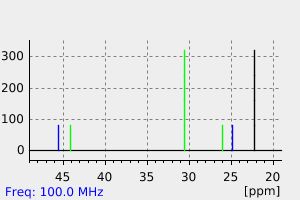2-异丁基-1,3-二噻烷 | 69824-23-3
中文名称
2-异丁基-1,3-二噻烷
中文别名
——
英文名称
2-(2-methylpropyl)-1,3-dithiane
英文别名
2-(i-butyl)-1,3-dithiane;2-isobutyl-1,3-dithiane;2-Isobutyl-1,3-dithian;2-isobutyl-[1,3]dithiane;2-sek.-Butyl-1,3-dithian
CAS
69824-23-3
化学式
C8H16S2
mdl
MFCD00040290
分子量
176.347
InChiKey
WGIHYSKTNRQNHP-UHFFFAOYSA-N
BEILSTEIN
——
EINECS
——
-
物化性质
-
计算性质
-
ADMET
-
安全信息
-
SDS
-
制备方法与用途
-
上下游信息
-
文献信息
-
表征谱图
-
同类化合物
-
相关功能分类
-
相关结构分类
计算性质
-
辛醇/水分配系数(LogP):3.5
-
重原子数:10
-
可旋转键数:2
-
环数:1.0
-
sp3杂化的碳原子比例:1.0
-
拓扑面积:50.6
-
氢给体数:0
-
氢受体数:2
安全信息
-
安全说明:S26,S36/37/39
-
危险类别码:R36/37/38
-
海关编码:2934999090
-
储存条件:应将物品存放在密封容器中,并置于阴凉、干燥处。存储地点需远离氧化剂,以防接触湿气和水分。
SDS
反应信息
-
作为反应物:描述:参考文献:名称:使用硅胶负载的硝酸铜从肟、甲苯磺酰腙、1,3-二硫戊环和 1,3-二噻烷中高效再生羰基化合物摘要:以硅胶为载体的硝酸铜在从肟、甲苯磺酰腙、1,3-二硫戊环和 1,3-二噻烷中再生醛和酮方面非常有效。DOI:10.1246/cl.1995.507
-
作为产物:参考文献:名称:Synthesis of (-)-Idiadione, a Furanosesterterpene Isolated from a Marine Sponge Spongia idia摘要:(-)-依达酮(1),是一种从海绵Spongia idia中分离出的呋喃二萜类化合物,其合成过程以(S)-(-)-香叶醛(2)为起始物质。天然存在的1的绝对构型被确定为(S)。DOI:10.3987/com-01-9311
文献信息
-
Can relief of ring-strain in a cyclopropylmethyllithium drive the Brook rearrangement?作者:Jonathan Clayden、David W. Watson、Mark ChambersDOI:10.1016/j.tet.2004.10.099日期:2005.32]-Brook rearrangement led to α-silyloxy organolithiums which on warming underwent cyclopropane ring opening and [1,5]-retro-Brook rearrangement to yield γ-silyl ketones. Despite the favourability of the cyclopropane ring opening, the Brook rearrangement still required the presence of an anion stabilising group to proceed. β-Silylketones were similarly formed by Brook–retro-Brook rearrangement on warming
-
Highly Diastereoselective Formation of 1,2,3-Trisubstituted Cyclopropane Derivatives作者:Xingang Xie、Guoren Yue、Shouchu Tang、Xing Huo、Qiren Liang、Xuegong She、Xinfu PanDOI:10.1021/ol051653t日期:2005.9.1A highly diastereoselective formation of cyclopropane derivatives was reported. When the chiral phenylvinyl epoxide reacted with lithiated 2-alkyl-1,3-dithiane or lithiated alkyl carbonanion in the presence of HMPA, cyclopropanes bearing stereochemistry at all three positions on the ring were readily obtained in high yields of 80-97% and high dr values of 68:32-99:1. This reaction was supposed to be
-
1,3-Dithianes as Assembling Ligands for the Construction of Copper(I) Coordination Polymers. Investigation of the Impact of the RC(H)S<sub>2</sub>C<sub>3</sub>H<sub>6</sub>Substituent and Reaction Conditions on the Architecture of the 0D–3D Networks作者:Abhinav Raghuvanshi、Michael Knorr、Lena Knauer、Carsten Strohmann、Stéphanie Boullanger、Virginie Moutarlier、Lydie ViauDOI:10.1021/acs.inorgchem.9b00114日期:2019.5.6(CP2) was isolated upon treatment of CuBr with L1. In contrast, treatment of L1 with CuCl results in the formation of 2D polymeric [Cu(μ2-Cl)2Cu}(μ2-L1)]n (CP3), in which each sulfur atom acts as a 4-electron donor. The 1D compounds [Cu(μ2-X)2Cu}(μ2-L2)2]n (CP7, X = Br, and CP8, X = Cl) resulting from treatment of 2-methyl-1,3 dithiane (L2) with CuBr and CuCl are isostructural with their CuI homologue母体化合物1,3-二噻烷(L1)与碘化亚铜提供1D配位聚合物[铜(μ反应2 -I)2 Cu}合金(μ 2 - L1)2 ] Ñ(CP1),一个同构化合物[铜(μ 2 -Br)2 Cu}合金(μ 2 - L1)2 ] ñ(CP2)处理后的CuBr与分离L1。与此相反,治疗的L1与氯化亚铜导致2D聚合物[铜(μ形成2 -Cl)2 Cu}合金(μ 2- L1)] Ñ(CP3),其中每个硫原子作为一个4 -电子给体。一种维化合物[的Cu(μ 2 -X)2 Cu}合金(μ 2 - L2)2 ] Ñ(CP7,X = Br和CP8,X = Cl)的从治疗的2-甲基-1,3-二噻烷所得(L2)与溴化亚铜和氯化亚铜是同构与其同源的CuI [的Cu(μ 2 -I)2 Cu}合金(μ 2 - L2)2 ] ñ(CP5),以前的报告。使用CuCN,组成为[Cu(μ2 -CN)2 Cu}合金(μ 2 -
-
硼酸和硼酸酯类化合物及其制备方法和用途
-
Studies directed toward the synthesis of reiswigin A: Total synthesis of (±)-<i>epi</i>-reiswigin A作者:David I MaGee、Dean E ShannonDOI:10.1139/v03-210日期:2004.2.1As a testing ground for the practical application of asymmetric synthesis, (-)-reiswigin A, a potent antiviral agent, was chosen as a target for total synthesis. Initial studies were undertaken to prove the viability of the key asym- metric step, enantioselective deprotonation of an intermediate meso-bicyclic ketone, using a chiral lithium amide base. Enantiomeric excesses in the range of 90%-94% were作为不对称合成实际应用的试验场,(-)-reiswigin A 是一种有效的抗病毒剂,被选为全合成的目标。进行了初步研究以证明关键的不对称步骤的可行性,即使用手性氨基化锂碱对中间体双环酮进行对映选择性去质子化。常规获得 90%-94% 范围内的对映体过量,即使在运行大至 10 g 时也是如此。不幸的是,这种关键的对映体富集中间体向天然产物的转化被证明是不成功的。在进行这些研究时,使用外消旋化合物的平行合成转化为 (±)-epi-reiswigin A。 简历: Comme methode d'application pratique de synthese asymetrique, la cible choisie a ete la (-)-reiswigine A,联合国代理抗病毒强力。Les etudes initiales ont ete entreprises Pour montrer
表征谱图
-
氢谱1HNMR
-
质谱MS
-
碳谱13CNMR
-
红外IR
-
拉曼Raman
-
峰位数据
-
峰位匹配
-
表征信息
同类化合物
硫化膦,1,3-二硫烷-2-基甲基苯基-
硅烷,三甲基(2-甲基-1,3-二硫烷-2-基)-
沙丙喋呤中间体
四氢-1,2-二噻英
反式-1,2-二噻烷-4,5-二醇1,1-二氧化物
八氟-1,4-二噻烷
二(1,3-二噻烷-2-基)甲烷-D
二(1,3-二噻烷-2-基)甲烷
丁二腈,2,3-二[(1,1-二甲基乙基)硫代]-2,3-二(1,3-二硫烷-2-基甲基)-
N-乙基-1,3-二噻烷-2-亚胺
N-(1,3-二硫杂环戊-2-亚基)氨基磷酸二甲酯
N,N’-1,6-己烷二基双氨基甲酸双(1,3-二噻烷-2-基甲基)酯
5alpha-[N-(亚硝基氨基甲酰)-N-(2-氯乙基)氨基]-2beta-甲基-1,3-二噻烷1,1,3,3-四氧化物
5,6-二氢-4H-1,3-二噻英-2-硫酮
4-甲基-2,6,7-三硫杂二环[2.2.2]辛烷
4-(丙氧基甲基)-2,6,7-三硫杂二环[2.2.2]辛烷
3-(1,3-二噻烷-5-基)-1-(2-氟乙基)-1-亚硝基脲
3-(1,3-二噻烷-2-亚基)-2,4-戊二酮
3,3-二甲基二环[2.2.1]庚烷-2-甲醇
2-苯基-1,3-二噻烷锂盐
2-苯基-1,3-二噻烷
2-脱氧-D-阿拉伯糖-己糖亚丙基二硫代缩醛
2-甲基-1,3-二噻烷
2-戊基-1,3-二噻烷
2-异丙基-1,3-二噻烷
2-异丁基-1,3-二噻烷
2-乙炔基-1,3-二噻烷
2-乙基-1,3-二噻烷
2-三甲基硅基-1,3-二噻吩
2-(叔丁基二甲基甲硅烷基)-1,3-二噻烷
2-(三异丙基甲硅烷基)-1,3-二噻烷
2-(3,4-二羟基苯基)-5,7-二羟基-6-[(2S,3R,4R,5S,6R)-3,4,5-三羟基-6-(羟甲基)四氢-2H-吡喃-2-基]-8-[(2S,3R,4S,5S)-3,4,5-三羟基四氢-2H-吡喃-2-基]-4H-色烯-4-酮(non-preferredname)
2-(1,3-二噻烷-2-基)乙醇
2,5-二甲基-2,5-二羟基-1,4-二噻烷
2,5-二甲基-2,5-二羟基-1,4-二噻烷
2,5-二乙氧基-1,4-二噻烷
2,2’-乙烯双(1,3-二噻烷)
2,2-双(三甲基硅基)二噻烷
2,2-二氟-1,3-二噻烷
2,2'-(1,2-亚苯基)二(1,3-二噻烷)
1-(2-氯乙基)-3-(2alpha-甲基-1,3-二噻烷-5alpha-基)-3-亚硝基脲
1-(2-氯乙基)-3-(1,3-二噻烷-5-基)-1-亚硝基脲
1-(2-氯乙基)-1-亚硝基-3-(1,1,3,3-四氧代-1,3-二噻烷-5-基)脲
1-(2-氟乙基)-1-亚硝基-3-(1,1,3,3-四氧代-1,3-二噻烷-5-基)脲
1-(1,3-二噻烷-2-基)乙酮
1-(1,3-二噻烷-2-基)-2-环己烯-1-醇
1-(1,3-二噻烷-2-基)-2,2,2-三氟乙烷酮
1,8-二羟基-2,9-二硫杂三环[8.4.0.03,8]十四烷
1,5,7,11-四硫杂螺[5.5]十一烷
1,4-苯并二噻英,八氢-







